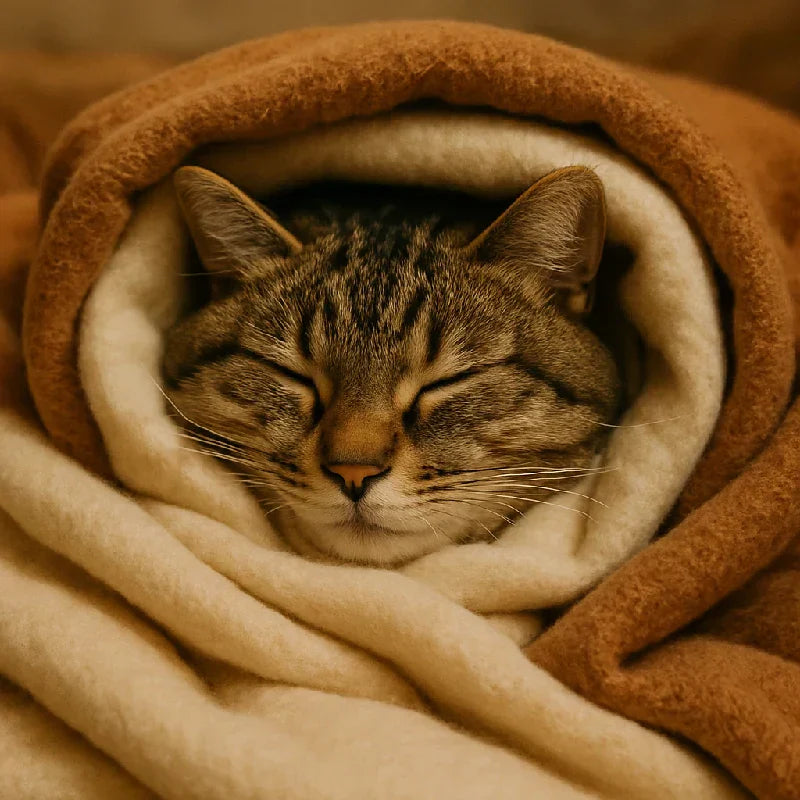Cats always give people a sense of independence and toughness, as if nothing can defeat them. But in fact, our furry friends may also get into trouble in cold weather.
Did you know? Cats can also suffer from hypothermia, which is a very serious condition that may occur when the temperature drops. Simply put, it may develop when a cat's body temperature falls below the normal range.
Therefore, it is particularly important to detect that something is wrong with the cat early. If you see them shivering, listless, or their gums turning pale, you must pay more attention. Especially in winter, as owners, we need to be more careful. Only by knowing more about these risks can we help cats avoid health problems.
This article will tell you in detail about the symptoms and prevention methods of feline hypothermia. By learning these, you can let your feline friends spend every cold period comfortably and warmly.
What is feline hypothermia?
Feline hypothermia is caused by a significant drop in their body temperature. Under normal circumstances, a cat's body temperature is between 100.5°F and 102.5°F (approximately 38.1°C to 39.2°C). Once it is lower than this range, hypothermia may occur.
In cold environments, especially places without heating, cats can be in danger. At this time, we must pay attention to their condition all the time. Cats such as short-haired cats and those with poor health are more vulnerable, and we need to be more careful with them.
Feline hypothermia is the body's response to cold weather. When the body temperature drops, various uncomfortable symptoms may appear. The following signs may indicate that a cat has hypothermia:
- Shivering and trembling
- Listlessness and laziness
- Gums turning pale or even blue
Knowing these symptoms allows us to take action quickly. Sometimes, our early detection and handling can make the difference between the cat's recovery and danger.

Causes of feline hypothermia
Feline hypothermia may be caused by several external conditions. Staying in cold weather for a long time is the main reason, especially for cats that do not have enough shelter outdoors.
In addition, if a cat's fur is wet, it is also prone to hypothermia. Because water will make heat escape faster, hypothermia may come sooner. So in cold weather, if a cat's fur gets wet, its body temperature will drop much faster than usual.
The following situations may cause cats to suffer from hypothermia:
- Staying outdoors in freezing temperatures
- Getting caught in the rain or snow and not drying off
- Staying in a place without heating for a long time
Understanding these reasons, we can find ways to prevent it. Only by detecting these risks early can we keep our cats safe and warm.
Symptoms of feline hypothermia: What to look out for?
It is really important to recognize the symptoms of hypothermia. Cats are very good at hiding their discomfort, so early detection is crucial for their survival.
We need to pay more attention to the initial signs, such as shivering and listlessness, which indicate that the cat's body is trying to maintain heat. Taking action quickly at this time can avoid more serious consequences.
Cats with hypothermia may also have muscle stiffness. If there are situations such as slow heart rate and difficulty breathing, it is even more worrying. At this time, they must be taken to see a doctor immediately.
We also need to check the color of the cat's gums. If they turn pale or blue, it is a danger signal, indicating that blood circulation has problems due to too low body temperature.
Other symptoms to look out for include:
- Being less alert
- Being weak and walking unsteadily
- Behaving strangely or always hiding
A cat's limbs are also important places to judge whether they are affected by the cold. We should pay attention to:
- Ears, paws, and tail are feeling cold to the touch
- Skin is also feeling cold

Detecting these symptoms early can play a great role. We must be more careful in cold weather. Taking measures quickly may save the cat's life.
Risk factors: Which cats are most susceptible?
Some cats are more likely to get hypothermia. Only by understanding these risk factors can we better protect them. It is crucial to know the special weaknesses of our own cats.
Short-haired cats' fur is not so good at keeping them warm, so they are more vulnerable in cold weather. Cats living in places without heating also face the same risk.
A cat's health status will also make them more likely to get this disease. Cats with underlying diseases may have difficulty regulating their body temperature. Kittens and elderly cats are at higher risk because their physical functions are relatively weak.
The following groups of cats are most likely to get hypothermia:
- Short-haired cats
- Cats that are sick or have weak immunity
- Kittens and elderly cats
- Cats that are often outdoors
Understanding these, we need to be more careful when taking care of them in cold weather. We must put their health and warmth first.
First aid measures: What to do if a cat has hypothermia?
If you suspect that a cat has hypothermia, you must act quickly. First, gently move the cat to a warm place. Every minute and second is particularly important at this time.
Do not use direct heat sources. Instead, wrap the cat in a warm towel or blanket to make them comfortable and warm.
We need to carefully check the cat's breathing and heartbeat. If the cat loses consciousness, immediately ask a veterinarian for emergency help. Even if the symptoms seem mild, we must ask the veterinarian for advice.
First aid can be carried out according to the following steps:
- Move the cat to a warm place
- Wrap them in a warm and dry towel or blanket
- Do not use direct heating equipment
- Check breathing and heart rate
- Contact a veterinarian and follow their guidance
If we act quickly, the result may be very different. Understanding these first aid steps can help us deal with such situations in a timely manner.

How to prevent feline hypothermia?
To prevent hypothermia, first of all, cats should be kept indoors when it is extremely cold, especially short-haired cats or cats with poor health. A warm environment can provide them with the necessary protection.
Prepare a comfortable and warm sleeping place for the cat. Ensure that their nest is dry and comfortable, away from cold wind and not close to cold doors and windows.
We can refer to these suggestions to prevent hypothermia:
- Use pet-specific heating equipment
- Provide them with a warm and comfortable nest
- Block cold wind

We should not ignore outdoor cats. If your cat spends time outdoors, you must ensure that the outdoor nest is well-insulated, and it is dry, safe, and windproof.
Additional precautions for outdoor cats:
- Build an insulated outdoor nest
- Do not let cats stay outdoors unattended
- Ensure that the nest is dry and free of drafts
When to see a veterinarian?
If you suspect that a cat has hypothermia, it is very important to let a veterinarian check it in time. Handling it early can prevent more serious problems. We should observe whether there is anything wrong with the pet.
If the cat has these symptoms, we should ask a professional veterinarian for help:
- Shivering all the time
- Gums being pale or blue
- Being weak and always listless
As pet owners, we should trust our feelings. If we feel that something is wrong, we should be more careful rather than careless. Veterinarians can give professional guidance and carry out necessary treatment.
Common questions about cats in cold weather
In cold weather, cat owners often have various questions. It is important to know how to take care of cats in winter. The following are some common questions and answers:
❓Can indoor cats get hypothermia?
Yes, they may get it if they are in an environment without heating.
❓For cats, what temperature is considered too cold?
Below 45°F (approximately 7.2°C) is risky.
❓Do cats need to wear sweaters?
Not always, but wearing them will help.
Understanding this information can protect cats from the cold. We should pay more attention to the weather conditions and take preventive measures in time.
Conclusion: Protecting cats' safety in cold weather
In cold weather, cats rely on us to get warmth and safety. In extremely cold periods, we should pay more attention to them, provide them with a comfortable and warm environment, take them to see a veterinarian regularly, and ensure that they are healthy. Only by actively understanding and dealing with the problems caused by cold can we keep our cats happy and healthy all the time.


Share and get 15% off!
Simply share this product on one of the following social networks and you will unlock 15% off!